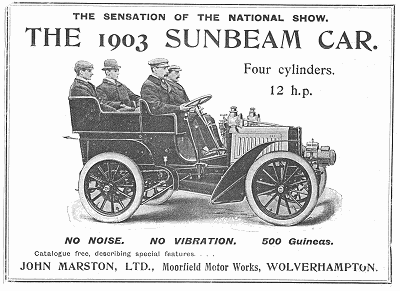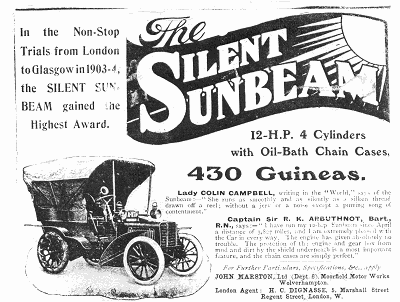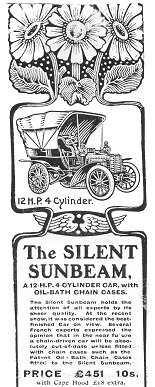Chapter Two
Part One
|
The year 1905 saw big
changes at Sunbeam, for in that year a new company would be
formed, quite separate from the cycle business to manufacture
cars. Thomas Pullinger had now left the Upper Villiers Street
works to join Humber at their Beeston works and the new company
was the Sunbeam Motor Car Company. |
 |
The first directors were John
Marston; Samuel Bayliss of Bayliss, Jones and Bayliss; Dr.
Deansley, one of John Marston's son in laws and for many
years Honorary Surgeon at the Royal Hospital, Wolverhampton;
Consulting Engineer Henry Bath; Thomas Cureton; and Herbert
Dignasse, owner of a large motor business in London, who
also acted as Sunbeam Export Manager, travelling all over
the world to promote sales of the Wolverhampton cars with
much success.
|
|
W.M. Iliffe was company
secretary from the beginning and would continue for many years,
also being secretary of the cycle company. Authorised capital of
the new company was £40,000.
Some little while before
the Sunbeam Motor Car Company was founded a drawing office had
been built along with factory extensions, this was considered a
bold move for at that time few firms had drawing offices which
were considered an unnecessary luxury.
|

An advert from 1904. |
|

Another 1904 advert. |
By now Berliet cars were
imported from France by a large London agent so Sunbeam needed
to look elsewhere or design much more themselves. It was
fortunate that Angus Shaw who had worked under Pullinger now
proved to be a first class designer. He was appointed Chief
Engineer and soon had his design for a 16/20 engine ready. Its
four cylinders were cast separately and had dimensions of 95 x
120mm. A sliding camshaft for the inlet valves controlled
engine speed, and magneto ignition was used. The four speed
gearbox of advanced design was fixed at three points to avoid
any strains and chain sprocket bearings were part of the gearbox
casting. The whole unit was made in two halves with a powerful
countershaft brake contained inside the box. The 16/20 would
prove to be a very successful car. Angus Shaw accompanied by
Ernest Eastmead drove one of these cars from London to John
O’Groats and back under official observation. The 1,756 miles
was achieved without once stopping the engine. During this
marathon journey 77 gallons of petrol were consumed which worked
out at 22.8m.p.g., a very creditable performance.
It could be seen that
there would be a good demand for this car, plans were afoot to
produce ten per week, and land that had been acquired sometime
previously was now used for further factory extensions in Upper
Villiers Street.
|

|

|
Return to
the beginning |
Proceed to
Part 2 |
|